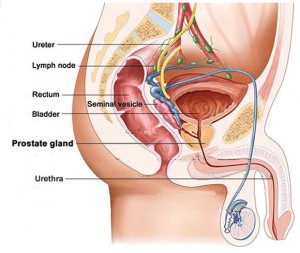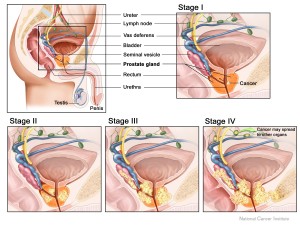 Generally, the tumor usually develops slowly and remains confined to the gland for many years. However, not prostate cancer does not involve the same way. A target for the aggressiveness of prostate cancer is the Gleason score (discussed in detail later in this article), designed by a qualified pathologist observing biopsies of the prostate during microscope. During this time, the tumor causes symptoms little or no outward signs (abnormalities on physical examination).
Generally, the tumor usually develops slowly and remains confined to the gland for many years. However, not prostate cancer does not involve the same way. A target for the aggressiveness of prostate cancer is the Gleason score (discussed in detail later in this article), designed by a qualified pathologist observing biopsies of the prostate during microscope. During this time, the tumor causes symptoms little or no outward signs (abnormalities on physical examination).
As the cancer advances, however, it can spread from the prostate into surrounding tissues (local spread). In addition, cancer can also metastasize (spread further) through other parts of the body such as bones, lungs and liver. Symptoms and characters, is more often associated with advanced prostate.
Prostatic intraepithelial neoplasia ( PIN ) : In BPH, the prostate gland to enlarge and prevents normal urine. The types of prostate cancer and leiomyosarcoma are rhabdomyosarcoma.
Prostate cancer : an abnormal growth of cells prostate hyperplasia is called BPH. The types of prostate cancer are clinically classified as Ad carcinomas: It’s the most common type of cancer compared to 95 percent of prostate cancer reported in this type.
In BPH, the prostate gland to enlarge and prevents the normal urine. The elsewhere, it can invade the lymph nodes in the pelvis, the bones of the spine, hip, pelvis and chest.
 The cause of prostate cancer is unknown, but cancer is not supposed to be related to benign prostatic hyperplasia (BPH). The risk of developing prostate cancer increases age. As Indeed, some studies have suggested that men over 80 years, 50% -80% of them have prostate cancer! Over 80% of prostate cancers are diagnosed in men aged 65 ages. These differences in diagnosis and mortality are more likely reflects a difference in factors such as environmental exposure, diet, lifestyle and seeking behavior rather than any racial sensitivity cancer. Thus prostate, prostate cancer for 40 years is extremely rare, while it is common in men older than 80 years.
The cause of prostate cancer is unknown, but cancer is not supposed to be related to benign prostatic hyperplasia (BPH). The risk of developing prostate cancer increases age. As Indeed, some studies have suggested that men over 80 years, 50% -80% of them have prostate cancer! Over 80% of prostate cancers are diagnosed in men aged 65 ages. These differences in diagnosis and mortality are more likely reflects a difference in factors such as environmental exposure, diet, lifestyle and seeking behavior rather than any racial sensitivity cancer. Thus prostate, prostate cancer for 40 years is extremely rare, while it is common in men older than 80 years.
As mentioned previously, African-American men are six times more likely than white men to develop prostate cancer. Recent studies show that this difference is gradually reduced potential for cure in men until the end of treatment for organ confined prostate cancer (cancer is confined within the prostate, without spread outside the prostate gland), regardless race. The risk (predisposing) factors for prostate cancer include age, genetics (heredity), and hormonal effects, such as environmental factors, such as toxins, chemicals and industrial products.
Prostate cancer is more common in family members of people with prostate cancer. Testosterone, the male hormone produced in the testes, directly stimulates the growth of both normal prostate tissue and prostate cells. Not surprising, therefore, this hormone is thought to be involved in the development and growth of prostate cancer. Genetics, as discussed above, plays a role in the risk of developing prostate cancer. The important implications of the role of this hormone are to reduce testosterone levels should be effective to inhibit the growth of prostate cancer. Earlier age at diagnosis in a first-degree relative and disease that affects more than one family member also increases the risk of developing prostate cancer.
The diagnostic procedures for prostate cancer are digital rectal examination (DRE), PSA cancer test. The treatments prostate cancer is surgery, radiotherapy, chemotherapy, hormonal therapy, cryosurgery, careful observation and follow-up testing. If the DRE or PSA shows abnormality, a biopsy is done for the patient.
No Comments Yet